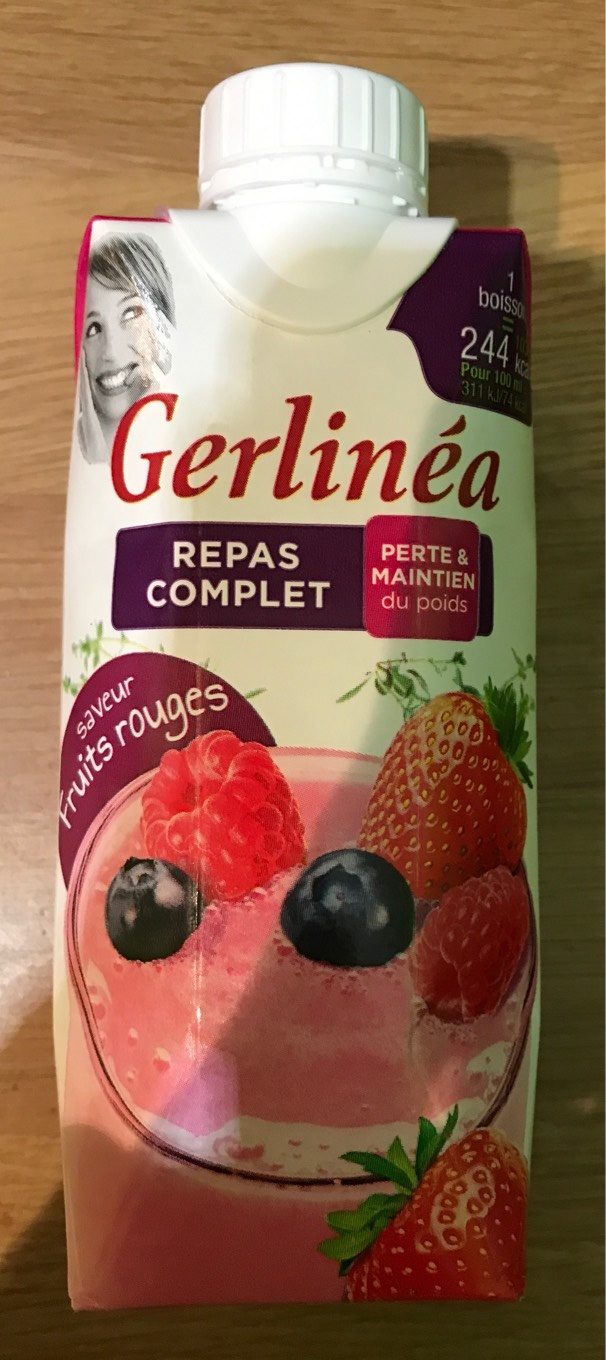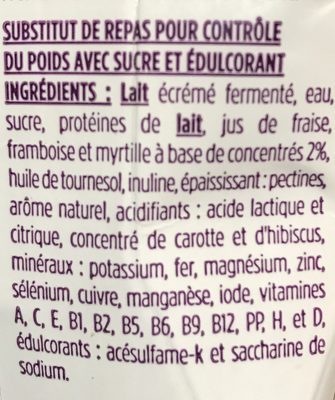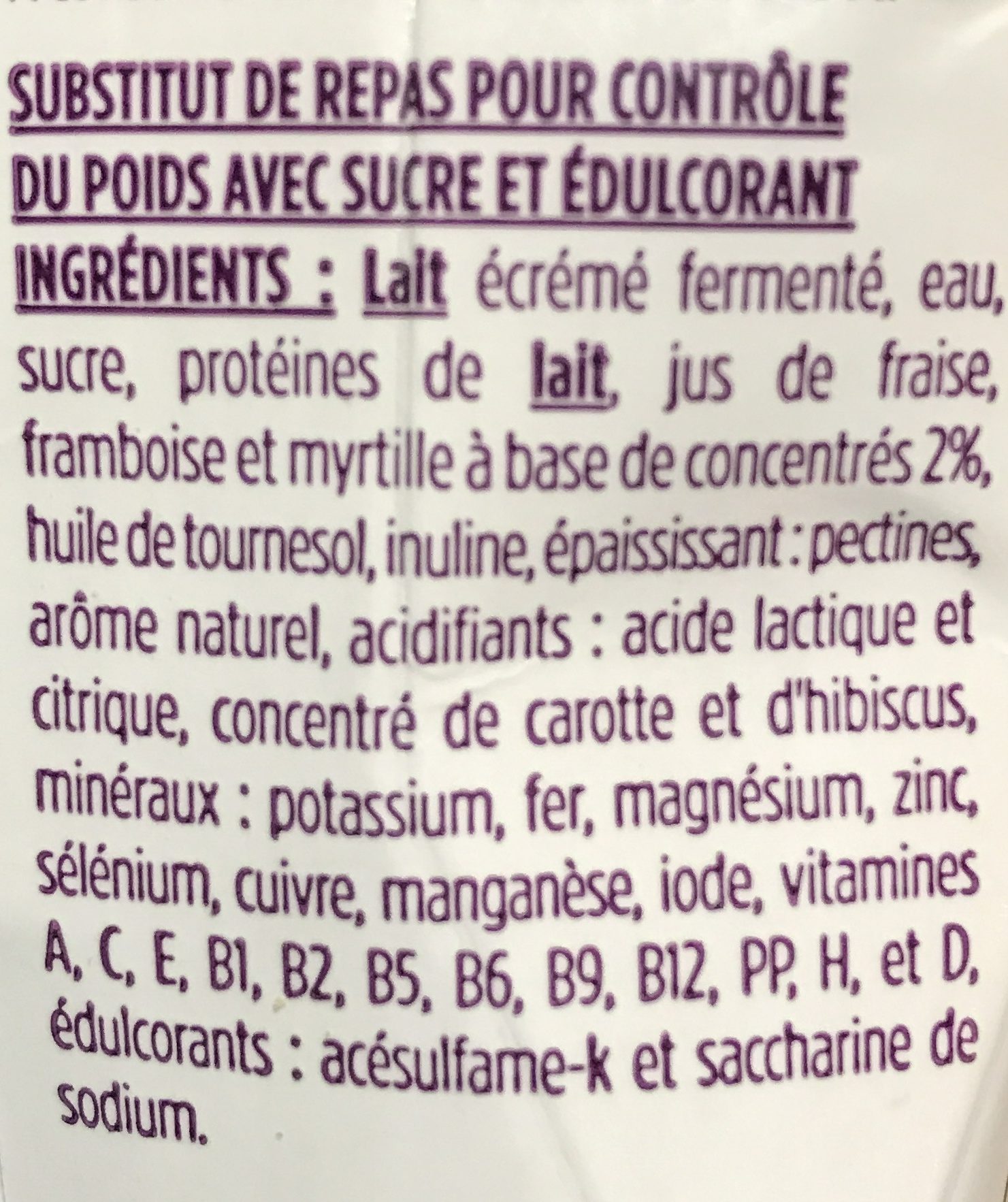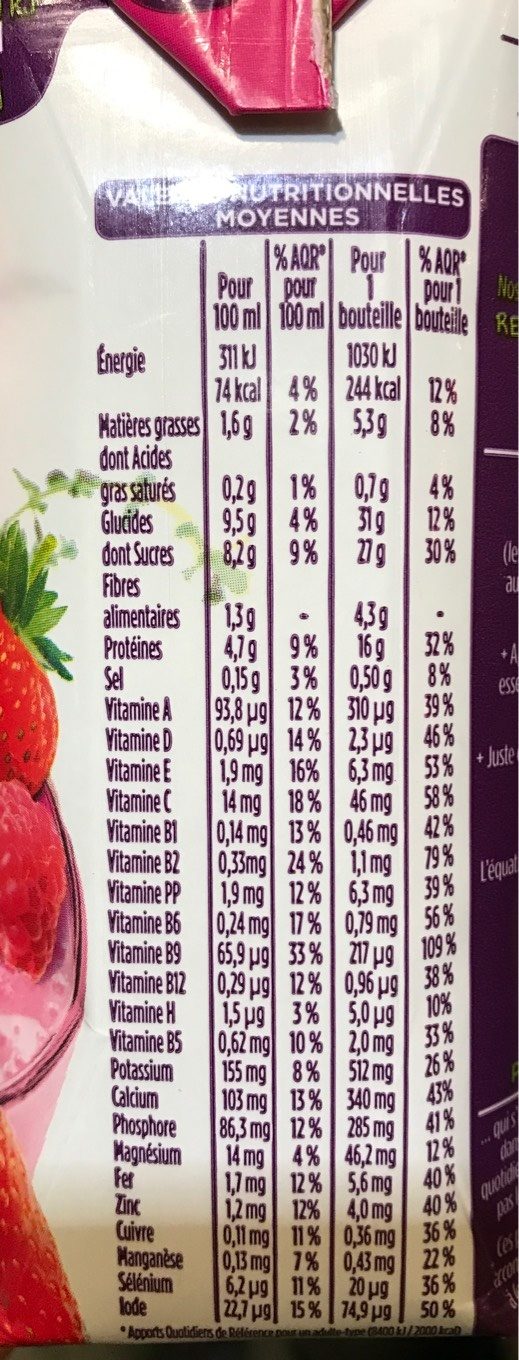Help us make food transparency the norm!
As a non-profit organization, we depend on your donations to continue informing consumers around the world about what they eat.
The food revolution starts with you!
Repas à boire minceur saveur fruits rouges GERLINEA - 330 mL
Repas à boire minceur saveur fruits rouges GERLINEA - 330 mL
This product page is not complete. You can help to complete it by editing it and adding more data from the photos we have, or by taking more photos using the app for Android or iPhone/iPad. Thank you!
×
Barcode: 3175681186378 (EAN / EAN-13)
Common name: Substitut de repas pour contrôle du poids avec sucre et édulcorant
Quantity: 330 mL
Packaging: Tetra Pak, Brick, Cardboard
Brands: Gerlinéa, Nutrition & Santé
Categories: Beverages, Meals, Artificially sweetened beverages, Meal replacements, fr:Produits minceur
Labels, certifications, awards: fr:Tetra Pak
Manufacturing or processing places: Allemagne
Traceability code: DE HE 001 EG
Link to the product page on the official site of the producer: https://www.gerlinea.fr/mon-repas-gerlin...
Stores: Carrefour
Countries where sold: France
Matching with your preferences
Health
Ingredients
-
40 ingredients
: lait écrémé fermenté, eau, sucre, protéines de lait, jus de fraise, framboise et myrtille à base de concentrés 2%, huile de tournesol, inuline, épaississant : pectines, arôme naturel, acidifiants : acide lactique et citrique, concentré de carotte et d'hibiscus, minéraux : potassium. fer, magnésium, zinc. sélénium, cuivre, manganèse, iode, vitamines A, C, E, B1, B2, B5, B6, B9, B12, PP, H, et D, édulcorants : acésulfame-k et saccharine de sodium.Allergens: Milk
Food processing
-
Ultra processed foods
Elements that indicate the product is in the 4 - Ultra processed food and drink products group:
- Additive: E440 - Pectins
- Additive: E950 - Acesulfame k
- Additive: E954 - Saccharin and its salts
- Ingredient: Flavouring
- Ingredient: Milk proteins
- Ingredient: Sweetener
- Ingredient: Thickener
Food products are classified into 4 groups according to their degree of processing:
- Unprocessed or minimally processed foods
- Processed culinary ingredients
- Processed foods
- Ultra processed foods
The determination of the group is based on the category of the product and on the ingredients it contains.
Additives
-
E270 - Lactic acid
Lactic acid: Lactic acid is an organic compound with the formula CH3CH-OH-COOH. In its solid state, it is white and water-soluble. In its liquid state, it is colorless. It is produced both naturally and synthetically. With a hydroxyl group adjacent to the carboxyl group, lactic acid is classified as an alpha-hydroxy acid -AHA-. In the form of its conjugate base called lactate, it plays a role in several biochemical processes. In solution, it can ionize a proton from the carboxyl group, producing the lactate ion CH3CH-OH-CO−2. Compared to acetic acid, its pKa is 1 unit less, meaning lactic acid deprotonates ten times more easily than acetic acid does. This higher acidity is the consequence of the intramolecular hydrogen bonding between the α-hydroxyl and the carboxylate group. Lactic acid is chiral, consisting of two optical isomers. One is known as L--+--lactic acid or -S--lactic acid and the other, its mirror image, is D--−--lactic acid or -R--lactic acid. A mixture of the two in equal amounts is called DL-lactic acid, or racemic lactic acid. Lactic acid is hygroscopic. DL-lactic acid is miscible with water and with ethanol above its melting point which is around 17 or 18 °C. D-lactic acid and L-lactic acid have a higher melting point. In animals, L-lactate is constantly produced from pyruvate via the enzyme lactate dehydrogenase -LDH- in a process of fermentation during normal metabolism and exercise. It does not increase in concentration until the rate of lactate production exceeds the rate of lactate removal, which is governed by a number of factors, including monocarboxylate transporters, concentration and isoform of LDH, and oxidative capacity of tissues. The concentration of blood lactate is usually 1–2 mM at rest, but can rise to over 20 mM during intense exertion and as high as 25 mM afterward. In addition to other biological roles, L-lactic acid is the primary endogenous agonist of hydroxycarboxylic acid receptor 1 -HCA1-, which is a Gi/o-coupled G protein-coupled receptor -GPCR-.In industry, lactic acid fermentation is performed by lactic acid bacteria, which convert simple carbohydrates such as glucose, sucrose, or galactose to lactic acid. These bacteria can also grow in the mouth; the acid they produce is responsible for the tooth decay known as caries. In medicine, lactate is one of the main components of lactated Ringer's solution and Hartmann's solution. These intravenous fluids consist of sodium and potassium cations along with lactate and chloride anions in solution with distilled water, generally in concentrations isotonic with human blood. It is most commonly used for fluid resuscitation after blood loss due to trauma, surgery, or burns.Source: Wikipedia
-
E440 - Pectins
Pectins (E440) are natural carbohydrates, predominantly found in fruits, that act as gelling agents in the food industry, creating the desirable jelly-like texture in jams, jellies, and marmalades.
Pectins stabilize and thicken various food products, such as desserts, confectioneries, and beverages, ensuring a uniform consistency and quality.
Recognized as safe by various health authorities, pectins have been widely used without notable adverse effects when consumed in typical dietary amounts.
-
E950 - Acesulfame k
Acesulfame potassium: Acesulfame potassium - AY-see-SUL-faym-, also known as acesulfame K -K is the symbol for potassium- or Ace K, is a calorie-free sugar substitute -artificial sweetener- often marketed under the trade names Sunett and Sweet One. In the European Union, it is known under the E number -additive code- E950. It was discovered accidentally in 1967 by German chemist Karl Clauss at Hoechst AG -now Nutrinova-. In chemical structure, acesulfame potassium is the potassium salt of 6-methyl-1‚2,3-oxathiazine-4-3H--one 2‚2-dioxide. It is a white crystalline powder with molecular formula C4H4KNO4S and a molecular weight of 201.24 g/mol.Source: Wikipedia
-
E954 - Saccharin and its salts
Saccharin: Sodium saccharin -benzoic sulfimide- is an artificial sweetener with effectively no food energy. It is about 300–400 times as sweet as sucrose but has a bitter or metallic aftertaste, especially at high concentrations. Saccharin is used to sweeten products such as drinks, candies, cookies, and medicines.Source: Wikipedia
Ingredients analysis
-
Palm oil free
No ingredients containing palm oil detected
Unrecognized ingredients: fr:framboise-et-myrtille-a-base-de-concentres, fr:acide-lactique-et-citrique, fr:et-dSome ingredients could not be recognized.
We need your help!
You can help us recognize more ingredients and better analyze the list of ingredients for this product and others:
- Edit this product page to correct spelling mistakes in the ingredients list, and/or to remove ingredients in other languages and sentences that are not related to the ingredients.
- Add new entries, synonyms or translations to our multilingual lists of ingredients, ingredient processing methods, and labels.
If you would like to help, join the #ingredients channel on our Slack discussion space and/or learn about ingredients analysis on our wiki. Thank you!
-
Non-vegan
Non-vegan ingredients: Skimmed milk, Milk proteinsSome ingredients could not be recognized.
We need your help!
You can help us recognize more ingredients and better analyze the list of ingredients for this product and others:
- Edit this product page to correct spelling mistakes in the ingredients list, and/or to remove ingredients in other languages and sentences that are not related to the ingredients.
- Add new entries, synonyms or translations to our multilingual lists of ingredients, ingredient processing methods, and labels.
If you would like to help, join the #ingredients channel on our Slack discussion space and/or learn about ingredients analysis on our wiki. Thank you!
-
Vegetarian status unknown
Unrecognized ingredients: fr:framboise-et-myrtille-a-base-de-concentres, fr:acide-lactique-et-citrique, Potassium, Iron, Magnesium, Zinc, Selenium, Copper, Manganese, Iodine, Vitamin E, Thiamin, Folic acid, Vitamin b12, fr:et-dSome ingredients could not be recognized.
We need your help!
You can help us recognize more ingredients and better analyze the list of ingredients for this product and others:
- Edit this product page to correct spelling mistakes in the ingredients list, and/or to remove ingredients in other languages and sentences that are not related to the ingredients.
- Add new entries, synonyms or translations to our multilingual lists of ingredients, ingredient processing methods, and labels.
If you would like to help, join the #ingredients channel on our Slack discussion space and/or learn about ingredients analysis on our wiki. Thank you!
-
Details of the analysis of the ingredients
We need your help!
Some ingredients could not be recognized.
We need your help!
You can help us recognize more ingredients and better analyze the list of ingredients for this product and others:
- Edit this product page to correct spelling mistakes in the ingredients list, and/or to remove ingredients in other languages and sentences that are not related to the ingredients.
- Add new entries, synonyms or translations to our multilingual lists of ingredients, ingredient processing methods, and labels.
If you would like to help, join the #ingredients channel on our Slack discussion space and/or learn about ingredients analysis on our wiki. Thank you!
: _lait_ écrémé, eau, sucre, protéines de _lait_, jus de fraise, framboise et myrtille à base de concentrés 2%, huile de tournesol, inuline, épaississant (pectines), arôme naturel, acidifiants (acide lactique et citrique), concentré de carotte, d'hibiscus, minéraux (potassium, fer), magnésium, zinc, sélénium, cuivre, manganèse, iode, vitamines, vitamine A, vitamine C, vitamine E, vitamine B1, vitamine B2, vitamine B5, vitamine B6, vitamine B9, vitamine B12, vitamine PP, vitamine H, et D, édulcorants (acésulfame-k, saccharine de sodium)- _lait_ écrémé -> en:skimmed-milk - vegan: no - vegetarian: yes - ciqual_proxy_food_code: 19051 - percent_min: 2.94117647058824 - percent_max: 90
- eau -> en:water - vegan: yes - vegetarian: yes - ciqual_food_code: 18066 - percent_min: 2 - percent_max: 46
- sucre -> en:sugar - vegan: yes - vegetarian: yes - ciqual_proxy_food_code: 31016 - percent_min: 2 - percent_max: 8.2
- protéines de _lait_ -> en:milk-proteins - vegan: no - vegetarian: yes - percent_min: 2 - percent_max: 8.2
- jus de fraise -> en:strawberry-juice - vegan: yes - vegetarian: yes - ciqual_food_code: 13014 - percent_min: 2 - percent_max: 8.2
- framboise et myrtille à base de concentrés -> fr:framboise-et-myrtille-a-base-de-concentres - percent_min: 2 - percent: 2 - percent_max: 2
- huile de tournesol -> en:sunflower-oil - vegan: yes - vegetarian: yes - from_palm_oil: no - ciqual_food_code: 17440 - percent_min: 0 - percent_max: 2
- inuline -> en:inulin - vegan: yes - vegetarian: yes - percent_min: 0 - percent_max: 2
- épaississant -> en:thickener - percent_min: 0 - percent_max: 2
- pectines -> en:e440a - vegan: yes - vegetarian: yes - percent_min: 0 - percent_max: 2
- arôme naturel -> en:natural-flavouring - vegan: maybe - vegetarian: maybe - percent_min: 0 - percent_max: 2
- acidifiants -> en:acid - percent_min: 0 - percent_max: 2
- acide lactique et citrique -> fr:acide-lactique-et-citrique - percent_min: 0 - percent_max: 2
- concentré de carotte -> en:carrot-concentrate - vegan: yes - vegetarian: yes - ciqual_food_code: 20009 - percent_min: 0 - percent_max: 2
- d'hibiscus -> en:roselle-flower - vegan: yes - vegetarian: yes - percent_min: 0 - percent_max: 2
- minéraux -> en:minerals - percent_min: 0 - percent_max: 2
- potassium -> en:potassium - percent_min: 0 - percent_max: 2
- fer -> en:iron - percent_min: 0 - percent_max: 1
- magnésium -> en:magnesium - percent_min: 0 - percent_max: 2
- zinc -> en:zinc - percent_min: 0 - percent_max: 2
- sélénium -> en:selenium - percent_min: 0 - percent_max: 2
- cuivre -> en:copper - percent_min: 0 - percent_max: 2
- manganèse -> en:manganese - percent_min: 0 - percent_max: 2
- iode -> en:iodine - percent_min: 0 - percent_max: 2
- vitamines -> en:vitamins - vegan: yes - vegetarian: yes - percent_min: 0 - percent_max: 2
- vitamine A -> en:vitamin-a - vegan: yes - vegetarian: yes - percent_min: 0 - percent_max: 2
- vitamine C -> en:e300 - vegan: yes - vegetarian: yes - percent_min: 0 - percent_max: 2
- vitamine E -> en:vitamin-e - percent_min: 0 - percent_max: 2
- vitamine B1 -> en:thiamin - percent_min: 0 - percent_max: 2
- vitamine B2 -> en:e101 - vegan: maybe - vegetarian: yes - percent_min: 0 - percent_max: 2
- vitamine B5 -> en:pantothenic-acid - vegan: yes - vegetarian: yes - percent_min: 0 - percent_max: 2
- vitamine B6 -> en:vitamin-b6 - vegan: yes - vegetarian: yes - percent_min: 0 - percent_max: 2
- vitamine B9 -> en:folic-acid - percent_min: 0 - percent_max: 2
- vitamine B12 -> en:vitamin-b12 - percent_min: 0 - percent_max: 2
- vitamine PP -> en:e375 - vegan: maybe - vegetarian: maybe - percent_min: 0 - percent_max: 2
- vitamine H -> en:biotin - vegan: yes - vegetarian: yes - percent_min: 0 - percent_max: 2
- et D -> fr:et-d - percent_min: 0 - percent_max: 2
- édulcorants -> en:sweetener - percent_min: 0 - percent_max: 2
- acésulfame-k -> en:e950 - vegan: yes - vegetarian: yes - percent_min: 0 - percent_max: 2
- saccharine de sodium -> en:e954 - vegan: yes - vegetarian: yes - ciqual_food_code: 31064 - percent_min: 0 - percent_max: 1
Nutrition
-
Nutri-Score not-applicable
Not-applicable for the category: Meal replacements
⚠ ️Nutri-Score not applicable for this product category.Could you add the information needed to compute the Nutri-Score?
-
Nutrient levels
-
Fat in moderate quantity (1.6%)
What you need to know- A high consumption of fat, especially saturated fats, can raise cholesterol, which increases the risk of heart diseases.
Recommendation: Limit the consumption of fat and saturated fat- Choose products with lower fat and saturated fat content.
-
Saturated fat in low quantity (0.2%)
What you need to know- A high consumption of fat, especially saturated fats, can raise cholesterol, which increases the risk of heart diseases.
Recommendation: Limit the consumption of fat and saturated fat- Choose products with lower fat and saturated fat content.
-
Sugars in high quantity (8.2%)
What you need to know- A high consumption of sugar can cause weight gain and tooth decay. It also augments the risk of type 2 diabetes and cardio-vascular diseases.
Recommendation: Limit the consumption of sugar and sugary drinks- Sugary drinks (such as sodas, fruit beverages, and fruit juices and nectars) should be limited as much as possible (no more than 1 glass a day).
- Choose products with lower sugar content and reduce the consumption of products with added sugars.
-
Salt in moderate quantity (0.15%)
What you need to know- A high consumption of salt (or sodium) can cause raised blood pressure, which can increase the risk of heart disease and stroke.
- Many people who have high blood pressure do not know it, as there are often no symptoms.
- Most people consume too much salt (on average 9 to 12 grams per day), around twice the recommended maximum level of intake.
Recommendation: Limit the consumption of salt and salted food- Reduce the quantity of salt used when cooking, and don't salt again at the table.
- Limit the consumption of salty snacks and choose products with lower salt content.
-
-
Nutrition facts
Nutrition facts As sold
for 100 g / 100 mlAs sold
per serving (330 mL (une bouteille))Compared to: Meal replacements Energy 310 kj
(74 kcal)1,020 kj
(244 kcal)-76% Fat 1.6 g 5.28 g -83% Saturated fat 0.2 g 0.66 g -90% Carbohydrates 9.5 g 31.4 g -66% Sugars 8.2 g 27.1 g -6% Fiber 1.3 g 4.29 g -79% Proteins 4.7 g 15.5 g -78% Salt 0.15 g 0.495 g -79% Vitamin A 93.8 µg 310 µg -66% Vitamin D 0.69 µg 2.28 µg -80% Vitamin E 1.9 mg 6.27 mg -56% Vitamin C (ascorbic acid) 14 mg 46.2 mg -59% Vitamin B1 (Thiamin) 0.14 mg 0.462 mg -68% Vitamin B2 (Riboflavin) 0.33 mg 1.09 mg -27% Vitamin B3/PP (Niacin) 1.9 mg 6.27 mg -62% Vitamin B6 (Pyridoxin) 0.24 mg 0.792 mg -60% Vitamin B9 (Folic acid) 65.9 µg 217 µg -32% Vitamin B12 (cobalamin) 0.29 µg 0.957 µg -71% Biotin 1.5 µg 4.95 µg -90% Vitamin B5 (Pantothenic acid) 0.62 mg 2.05 mg -60% Potassium 155 mg 511 mg -72% Calcium 103 mg 340 mg -55% Phosphorus 86.3 mg 285 mg -70% Iron 1.7 mg 5.61 mg -73% Magnesium 14 mg 46.2 mg -85% Zinc 1.2 mg 3.96 mg -68% Copper 0.11 mg 0.363 mg -72% Manganese 0.13 mg 0.429 mg -87% Selenium 6.2 µg 20.5 µg -68% Iodine 22.7 µg 74.9 µg -53% Fruits‚ vegetables‚ nuts and rapeseed‚ walnut and olive oils (estimate from ingredients list analysis) 6.1 % 6.1 %
Environment
-
Eco-Score D - High environmental impact
⚠ ️Select a country in order to include the full impact of transportation.The Eco-Score is an experimental score that summarizes the environmental impacts of food products.→ The Eco-Score was initially developped for France and it is being extended to other European countries. The Eco-Score formula is subject to change as it is regularly improved to make it more precise and better suited to each country.Life cycle analysis
-
Average impact of products of the same category: D (Score: 30/100)
Category: Meal replacement low calorie, ready-to-drink
Category: Meal replacement low calorie, ready-to-drink
- PEF environmental score: 0.27 (the lower the score, the lower the impact)
- including impact on climate change: 2.31 kg CO2 eq/kg of product
Stage Impact Agriculture
56.7 %Processing
17.1 %Packaging
15.9 %Transportation
5.9 %Distribution
3.5 %Consumption
0.9 %
Bonuses and maluses
-
Missing origins of ingredients information
Malus: -5
⚠ ️ The origins of the ingredients of this product are not indicated.
If they are indicated on the packaging, you can modify the product sheet and add them.
If you are the manufacturer of this product, you can send us the information with our free platform for producers.
-
Packaging with a medium impact
Malus: -5
Shape Material Recycling Impact Brick Tetra Pak Medium Unknown Cardboard Low ⚠ ️ The information about the packaging of this product is not sufficiently precise (exact shapes and materials of all components of the packaging).⚠ ️ For a more precise calculation of the Eco-Score, you can modify the product page and add them.
If you are the manufacturer of this product, you can send us the information with our free platform for producers.
Eco-Score for this product
-
Impact for this product: D (Score: 20/100)
Product: Repas à boire minceur saveur fruits rouges GERLINEA - 330 mL
Life cycle analysis score: 30
Sum of bonuses and maluses: -10
Final score: 20/100
-
Carbon footprint
-
Equal to driving 1.2 km in a petrol car
231 g CO² per 100g of product
The carbon emission figure comes from ADEME's Agribalyse database, for the category: Meal replacement low calorie, ready-to-drink (Source: ADEME Agribalyse Database)
Stage Impact Agriculture
68.8 %Processing
12.1 %Packaging
8.3 %Transportation
8.7 %Distribution
1.7 %Consumption
0.3 %
Packaging
-
Packaging with a medium impact
-
Packaging parts
Brick (Tetra Pak)
(Cardboard)
-
Packaging materials
Material % Packaging weight Packaging weight per 100 g of product Paper or cardboard
-
Transportation
-
Origins of ingredients
Missing origins of ingredients information
⚠ ️ The origins of the ingredients of this product are not indicated.
If they are indicated on the packaging, you can modify the product sheet and add them.
If you are the manufacturer of this product, you can send us the information with our free platform for producers.Add the origins of ingredients for this product Add the origins of ingredients for this product
Report a problem
-
Incomplete or incorrect information?
Category, labels, ingredients, allergens, nutritional information, photos etc.
If the information does not match the information on the packaging, please complete or correct it. Open Food Facts is a collaborative database, and every contribution is useful for all.
Data sources
Product added on by kiliweb
Last edit of product page on by packbot.
Product page also edited by loverock, openfoodfacts-contributors, yuka.V2I0Sk5hY3R2dGN6bWNVMXBRek0zNDRvNjVLRFFqcUxETUVTSVE9PQ.











